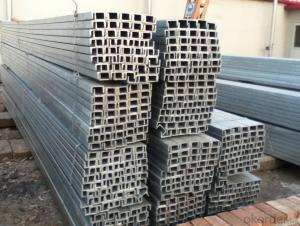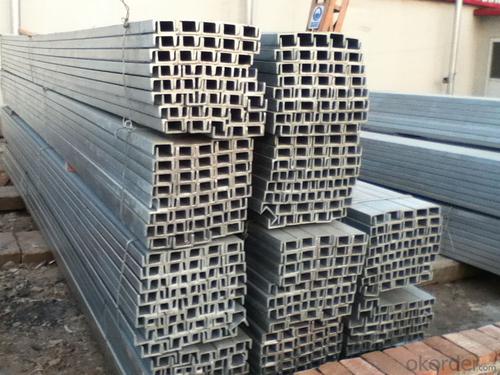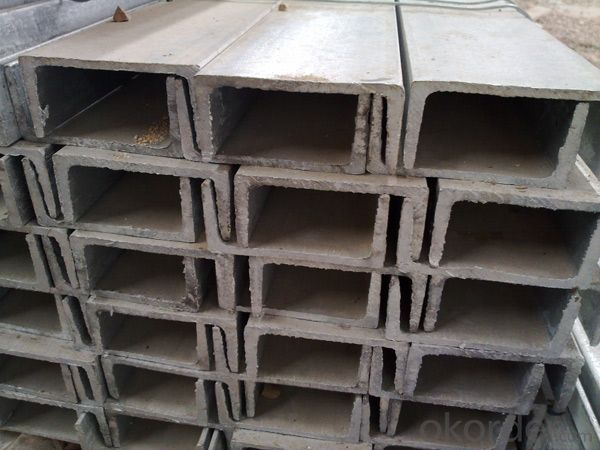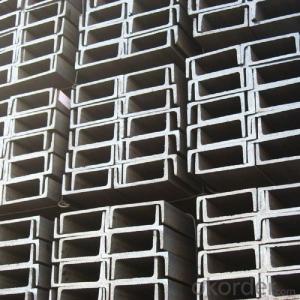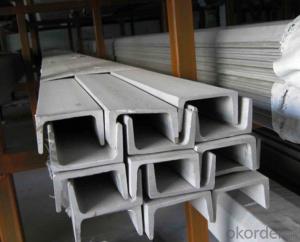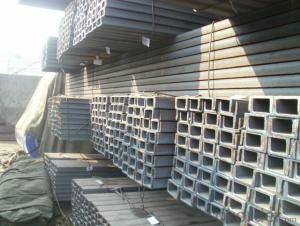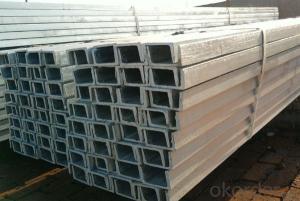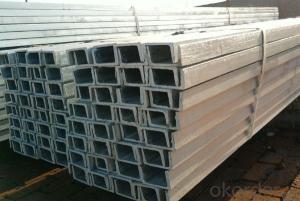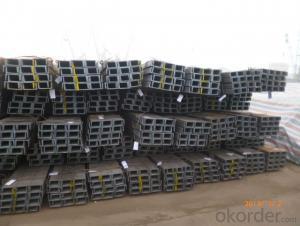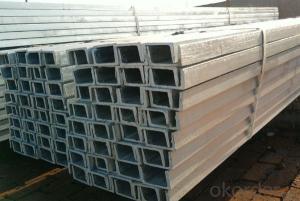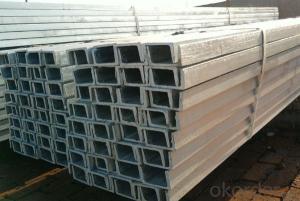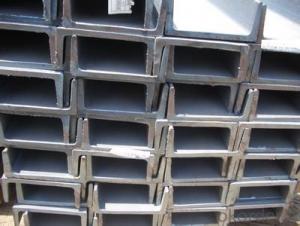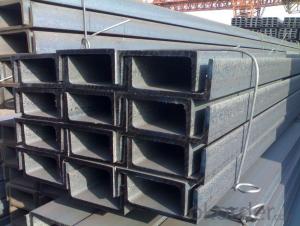JIS U CHANNEL high quality hot rolled all sizes
- Loading Port:
- Tianjin
- Payment Terms:
- TT OR LC
- Min Order Qty:
- 25 m.t.
- Supply Capability:
- 100000 m.t./month
OKorder Service Pledge
OKorder Financial Service
You Might Also Like
channel Details:
| Minimum Order Quantity: | Unit: | m.t. | Loading Port: | ||
| Supply Ability: | Payment Terms: | Package: | wire rod bundle |
Product Description:
Product Description:
Specifications of MS Channel:
1.We supply high quality MS Channel at reasonable price, including Chinese standard, Japanese standard and so on.
Standard | GB/JIS |
Material Grade | Q235,SS400 |
Technique: | Hot Rolled |
Sizes as per chinese standard: | 50*37*4.5mm - 300*89*11.5mm |
Sizes as per japanese standard: | 50*25*3mm – 200*80*7.5mm |
Length: | 6meter, 9meter, 12meter |
Note: 1.we are also competent to provide our customers other MS Channel based on other sizes according to customer’s requirements.
2. The length of our ms channel could be cut into other meters as per customer’s requirements. For example, the channel in 6meters could be cut into 5.8meters in order to be fit in the 20ft container.
2. The detailed sections of MS Channel as per GB standard.are shown in the table-1:
GB U CHANNEL | Standard | Sectional | Dimension |
| Mass: |
(mm) | (mm) | (mm) | (mm) | ||
50X37 | 50 | 37 | 4.50 | 7.0 | 5.438 |
63X40 | 63 | 40 | 4.80 | 7.5 | 6.634 |
80x43 | 80 | 43 | 5.00 | 8.0 | 8.045 |
100x48 | 100 | 48 | 5.30 | 8.5 | 10.007 |
120x53 | 120 | 53 | 5.50 | 9.0 | 12.059 |
140x58 | 140 | 58 | 6.00 | 9.5 | 14.535 |
140x60 | 140 | 60 | 8.00 | 9.5 | 16.733 |
160x63 | 160 | 63 | 6.50 | 10.0 | 17.240 |
160x65 | 160 | 65 | 8.50 | 10.0 | 19.752 |
180x68 | 180 | 68 | 7.00 | 10.5 | 20.174 |
180x70 | 180 | 70 | 9.00 | 10.5 | 23.000 |
200x73 | 200 | 73 | 7.00 | 11.0 | 22.637 |
200x75 | 200 | 75 | 9.00 | 11.0 | 25.777 |
220x77 | 220 | 77 | 7.00 | 11.5 | 24.999 |
220x79 | 220 | 79 | 9.00 | 11.5 | 28.453 |
250x78 | 250 | 78 | 7.00 | 12.0 | 27.410 |
250x80 | 250 | 80 | 9.00 | 12.0 | 31.335 |
250x82 | 250 | 82 | 11.00 | 12.0 | 35.260 |
280x82 | 280 | 82 | 7.50 | 12.5 | 31.427 |
280x84 | 280 | 84 | 9.50 | 12.5 | 35.823 |
280x86 | 280 | 86 | 11.50 | 12.5 | 40.219 |
300x85 | 300 | 85 | 7.50 | 13.5 | 34.463 |
300x87 | 300 | 87 | 9.50 | 13.5 | 39.173 |
300x89 | 300 | 89 | 11.50 | 13.5 | 43.883 |
Table-1
3. The chemical composition of HR Channel Steel according to Q235B is shown in Table-2.
Alloy No | Grade | Element(%) | ||||
C | Mn | S | P | Si | ||
Q235 | B | 0.12-0.20 | 0.3-0.7 | ≦0.045 | ≦0.045 | ≦0.3 |
Table-2
Note: we are able to present our customers relevant SGS test report for chemical composition of HR Channel Steel.
4. The mechanical property of HR Channel Steel according to Q235B is shown in Table-3-1 and Table-3-2
Alloy No | Grade | Yielding Strength Point(Mpa) | |||
Thickness(mm) | |||||
≦16 | >16-40 | >40-60 | >60-100 | ||
≧ | |||||
Q235 | B | 235 | 225 | 215 | 205 |
Table-3-1
Alloy No | Grade | Tensile Strength(Mpa) | Elongation After Fracture(%) | |||
Thickness(mm) | ||||||
≦16 | >16-40 | >40-60 | >60-100 | |||
≧ | ||||||
G235 | B | 375-500 | 26 | 25 | 24 | 23 |
Table-3-2
Note: we are able to present our customers relevant SGS test report for mechanical property of MS Channel as customer’s request.
Applications of MS Channel:
The MS Channel can be applied to construction of warehouses, workshops, sport stadiums and car parks etc.The hot rolled channel steel belongs to carbon structural steel which is applied to in the field of construction and machinery.In details, the hot rolled channel steel is usually used for arch-itechtural structure, and they could be welded in order to support or hang a vari-ety of facilities. They are also usually used in combination with I beam. Generally,the hot rolled channel steel we supply must possess perfect welding property, riveting property and mechanical property and so on.
Package & Delivery of MS Channel:
1.The hot rolled channel steel will be packed in bundle with steel wire at each end of every bundle and color marking in order to help the customer to recognize his goods more easily at sight.
2. And the hot rolled channel steel could be loaded into 20ft or 40ft container, or by bulk cargo.If the weight of each bundle reaches more than 3.5 mt, the loading by break bulk cargo should be choosed.When the weight of each bundle reaches less than 3mt, the loading by container should be choosed.
3.As for the transportaion from mill to loading port, the truck will be usually used. And the maximum quantity for each truck is 40mt.
4.All in all, we could do in accordance with customer's request
- Q: Can steel channels be used for mezzanine guardrails?
- Yes, steel channels can be used for mezzanine guardrails. Steel channels are often used for their strength and durability, making them suitable for providing a secure barrier and ensuring the safety of individuals on mezzanine floors.
- Q: Can steel channels be used for supporting curtain wall systems?
- Certainly, curtain wall systems can indeed rely on steel channels for support. In construction, steel channels are widely utilized for providing structural support and can effectively furnish the requisite strength and stability necessary to bear the weight of curtain wall systems. Furthermore, steel channels can be conveniently tailored and manufactured to suit the specific design prerequisites of the curtain wall system. By affixing them to the building structure, they furnish a secure anchoring point for the curtain wall system, thereby ensuring its steadfastness and optimal functionality. In general, the robustness, longevity, and adaptability of steel channels make them a preferred choice for supporting curtain wall systems.
- Q: Can steel channels be used in high-temperature environments?
- Certainly! Steel channels are capable of being utilized in environments with high temperatures. Steel, being a material that is both highly durable and resistant to heat, is able to endure high temperatures without compromising its structural integrity. It possesses a high melting point and is not easily deformed or weakened when subjected to extreme heat conditions. In industrial settings, steel channels are frequently employed in applications including furnaces, boilers, and equipment for high-temperature processing. Nonetheless, it is crucial to carefully consider the specific grade of steel being employed, as certain types may have restrictions in terms of their ability to resist high temperatures. Moreover, one must also take into account factors such as the duration and frequency of exposure to high temperatures when assessing the suitability of steel channels for a particular high-temperature environment.
- Q: Can steel channels be used for bracing purposes?
- Yes, steel channels can be used for bracing purposes. Steel channels are commonly used in construction and engineering projects to provide structural support and reinforcement. They are often used as bracing elements to enhance the stability and strength of structures, such as buildings, bridges, and other load-bearing applications.
- Q: What are the different types of connections for steel channels?
- Steel channels can be connected in various ways based on the specific application, load requirements, and structural design considerations. One commonly used connection type for steel channels is the bolted connection. This involves connecting the channels using bolts, usually with the assistance of nuts and washers. Bolted connections offer flexibility and easy installation, allowing for adjustments and disassembly when needed. They are suitable for applications that require a moderate level of load transfer. Another option is the welded connection, where the steel channels are joined together through welding. Welded connections provide high strength and rigidity, making them ideal for applications with heavy loads and a need for structural stability. Welding creates a permanent and durable connection, eliminating the need for additional fasteners. A combination of bolted and welded connections can also be used in certain cases. This hybrid approach combines the advantages of both connection types, resulting in a robust and efficient solution that meets specific design requirements. Specialized connections are available for specific applications as well. For instance, slip-resistant connections are used in situations where the channels need to withstand dynamic or lateral loads. These connections often incorporate features like serrated surfaces or special fasteners to enhance grip and prevent slippage. It is crucial to select the appropriate connection type for steel channels in accordance with relevant building codes, engineering standards, and structural analysis. It is recommended to consult with a structural engineer or design professional to ensure that the connections meet necessary safety and performance requirements.
- Q: How do steel channels contribute to the sustainability of a building?
- Steel channels contribute to the sustainability of a building in several ways. Firstly, they are highly durable and have a long lifespan, reducing the need for frequent replacements or repairs. This minimizes the overall environmental impact associated with the production and disposal of building materials. Additionally, steel channels can be easily recycled at the end of their life cycle, reducing waste and conserving natural resources. Furthermore, steel channels are lightweight, allowing for more efficient transportation and installation, which reduces energy consumption during construction. Lastly, steel channels provide structural strength and support, allowing for the design of more sustainable and space-efficient buildings.
- Q: Can steel channels be used for utility supports?
- Yes, steel channels can be used for utility supports. Steel channels are strong and durable, making them suitable for supporting various utilities such as electrical cables, plumbing pipes, and HVAC systems. They provide stability and can withstand the weight and pressure of the utilities, ensuring a secure and reliable support system.
- Q: How do steel channels contribute to the overall stability of a building?
- Steel channels contribute to the overall stability of a building by providing structural support and load-bearing capabilities. They are often used as beams or columns in construction, helping to distribute the weight of the building evenly and efficiently. The rigid and durable nature of steel channels enhances the building's ability to withstand external forces such as wind, earthquakes, or heavy loads, ensuring its stability and structural integrity.
- Q: Are steel channels suitable for modular construction practices?
- Yes, steel channels are suitable for modular construction practices. Steel channels provide excellent strength and durability, making them ideal for use in modular construction. They are commonly used in the construction of modular buildings, as they offer a reliable and sturdy framework for the structure. Steel channels are also versatile and can be easily customized to meet specific design needs, allowing for flexibility in modular construction. They can be cut, welded, and shaped according to the required dimensions, making them highly adaptable for modular construction projects. Furthermore, steel channels are lightweight compared to other construction materials, which makes them easier to transport and assemble in modular construction practices. This characteristic also contributes to the overall efficiency of modular construction, as it reduces time and labor costs during installation. In addition to their strength, versatility, and lightweight nature, steel channels are also resistant to corrosion, fire, and pests, ensuring the longevity and safety of modular structures. These properties make steel channels a reliable and suitable choice for modular construction practices.
- Q: What are the different types of bending for steel channels?
- There are several different types of bending methods that can be used for steel channels. These methods include cold bending, hot bending, and press brake bending. 1. Cold Bending: This method involves shaping the steel channel using force without heating it. It is a common method used for bending steel channels, as it is cost-effective and does not require specialized equipment. Cold bending can be done manually using tools such as hammers, pipe benders, or hydraulic benders. It is suitable for smaller and simpler bending projects. 2. Hot Bending: Hot bending involves heating the steel channel to a specific temperature before shaping it. This method is typically used for larger and more complex bending projects, as it allows for more precise and controlled bending. Hot bending is commonly done using induction heating or flame heating techniques. The heated steel channel is then bent using hydraulic or mechanical force. 3. Press Brake Bending: Press brake bending is a method that uses a machine called a press brake to bend steel channels. This method is highly accurate and suitable for large-scale production. The press brake machine consists of a punch and a die that are used to shape the steel channel. The steel channel is placed between the punch and the die, and the press brake applies force to bend it to the desired angle. Overall, the choice of bending method depends on factors such as the complexity of the bending project, the size of the steel channel, and the required precision. Each method has its own advantages and limitations, and it is important to choose the appropriate method based on these factors to ensure the desired outcome.
Send your message to us
JIS U CHANNEL high quality hot rolled all sizes
- Loading Port:
- Tianjin
- Payment Terms:
- TT OR LC
- Min Order Qty:
- 25 m.t.
- Supply Capability:
- 100000 m.t./month
OKorder Service Pledge
OKorder Financial Service
Similar products
Hot products
Hot Searches
Related keywords
